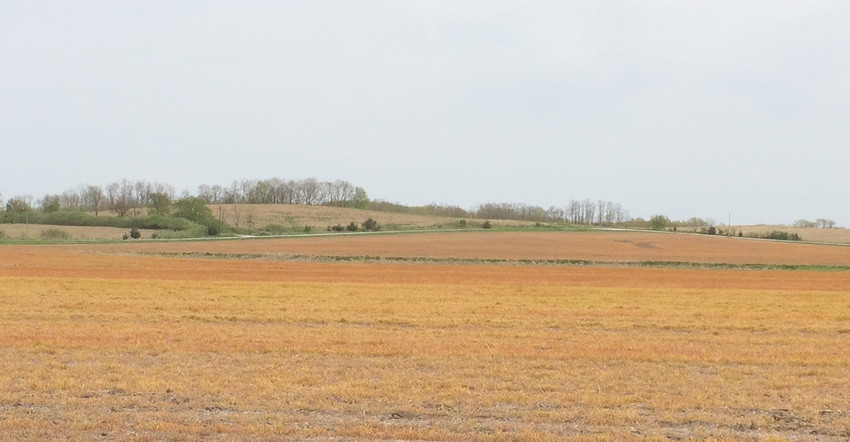April 22, 2019

Cover crops often have a dense canopy of rapidly maturing plants in the spring. That, combined with typically cool temperatures in April and May, leaves the door open for control failures with herbicides when applying them to terminate the cover crop.
Here are four questions my ISU Extension field agronomist colleagues and I often receive from farmers regarding termination of cover crops, along with our answers.
What’s the best way to terminate cereal rye? The best termination method for each farmer will depend on the person’s goals, but most conventional farmers find that glyphosate is both the easiest and most effective option currently available. Research has shown glyphosate provides more consistent control of cereal rye than glufosinate, paraquat or ACCase inhibiting herbicides, especially in the less-than-ideal conditions commonly found in the spring prior to crop planting.
ISU Extension suggests terminating cereal rye with at least 1-pound acid equivalent of glyphosate and AMS-treated water for best results. Midday applications in warm conditions are usually the most successful. My rule of thumb is I like to see an actively growing cover crop and at least 60-degree-F high temperatures and 40-degree low temperatures for the day of application and several days following. The weather doesn’t always cooperate, but we can try to find conditions close to these for best results.
Alternative options do exist for terminating cereal rye, but these are usually less consistent or require waiting until rye is flowering to kill it (usually mid to late May). Tillage is an option but requires both vertical and horizontal soil mixing to cut cover crop roots and bury plants. It often requires more than one pass for complete control.
Another termination method is roller-crimping. A roller-crimper lays cereal rye down and pinches or cuts the stems to stop the flow of nutrients and water in the plant. Farmers wanting to roller-crimp cereal rye will have the most success when the rye is headed out and producing pollen, or later. But this requires delaying termination, and thus, cash crop planting, until mid to late May.
Why do UAN or other herbicides sometimes cause termination failures? UAN and herbicides that cause a fast-foliar burn can reduce translocation of glyphosate in cereal rye. While the visual effect of these products may be satisfying, the damage may result in reduced control or slower death of the cover crop. While the antagonism associated with tank mixes is inconsistent, farmers new to cover crops might want to stick with glyphosate and AMS-treated water, especially during periods with less favorable conditions.
When should I kill my cereal rye cover crop? The answer to this question is the good old standby, “It depends.” ISU researchers are working to better answer this question as it relates to corn planting, but our current recommendation is to terminate cereal rye and other small grains 10 to 14 days prior to planting corn. This recommendation is due to the possibility of a dying cover crop acting as a green bridge for plant pathogens that might detrimentally effect corn seedlings.
Cover crops may harbor insect pests that can move to corn as the cover crop dies, so having a longer time frame between killing the cover crop and planting corn is desirable to reduce problems with black cutworms and true armyworms. Stay tuned for future recommendations for cover crop termination before corn as our ISU specialists dive into this question further.
Prior to soybean planting, farmers have much more flexibility. If planting equipment can effectively cut through residue and provide appropriate seed-soil contact, farmers can terminate cereal rye and other small grains up to or even shortly after planting soybeans, depending on where you are located in Iowa.
Crop insurance guidelines require that cover crops in much of the eastern part of the state be terminated at or within five days after planting but before cash crop emergence. Counties that are further west must terminate the cover crop at or before planting the cash crop. Reach out to your crop insurance agent for more information.
Will my cereal rye provide weed control when I kill it? Of the cover crop species commonly used in Iowa, cereal rye shows the best potential for suppressing weeds, particularly in the soybean year of our crop rotations. This is primarily due to its ability to accumulate sufficient dry matter to suppress weeds at typical, or slightly delayed, soybean planting dates. Research in other states has shown between 4,000 and 11,000 pounds of dry matter per acre is needed to provide in-season weed suppression.
In most years, cover crop biomass will not provide season-long weed control, but a uniform stand of cereal rye may provide significant early-season weed suppression. The three most important factors for success with cereal rye weed suppression include early planting date, delayed termination date, and a uniform stand with few or no gaps to allow weeds to escape through.
As cover crop adoption increases across the landscape, we want to make sure farmers feel well-prepared to handle these additional crops in their management system. Many questions may come to mind when considering how to implement cover crops in an individual management scheme or situation, so don’t hesitate to reach out to your local ISU Extension field agronomist for more answers (and maybe some more questions, too).
Anderson is an ISU Extension field agronomist covering central Iowa. Contact her at [email protected].
About the Author(s)
You May Also Like






